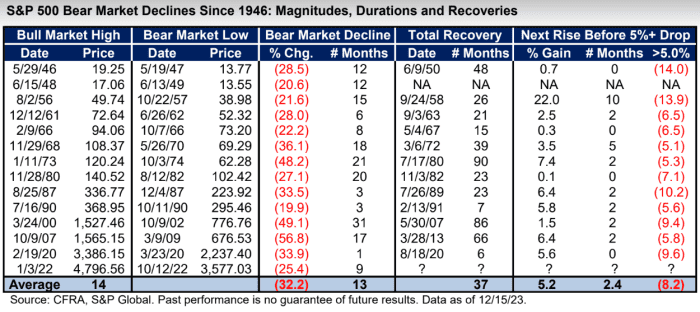It’s been a strange, if not historically long, trip for stock-market bulls, but after nearly two years, the S&P 500 is just a few points away from record territory.
The S&P 500 SPX, the U.S. large-cap benchmark, rose 20.12 points, or 0.4%, to close Tuesday at 4,774.75. That leaves the index less than 0.5% away from its record close at 4,796.56, set on Jan. 3, 2022.
Through Tuesday, it’s been 497 trading days since the S&P 500’s last record close. That’s the longest streak without a record since a 1,375-trading-day drought that ran from Oct. 9, 2007, to March 28, 2013, according to Dow Jones Market Data.
Stocks tumbled into a bear market last year as the Federal Reserve began aggressively hiking interest rates in an effort to rein in inflation, which had been running near a four-decade high. Equities tumbled as Treasury yields, which move opposite to debt prices, rose in response to tighter Fed monetary policy. Bonds, by some measures, suffered their worst year on record, delivering a rare double whammy to investors who typically see losses in stocks offset by gains in bonds or vice versa.
Stocks bottomed in October 2022, recovering some lost ground into year-end before beginning 2023 on an upswing as the Fed began to slow the pace of rate increases. The S&P 500 exited its bear market in June, rising more than 20% off its bear-market low set the previous October, before stumbling in late July.
That move met widely used criteria for the start of a new bull market, but some market watchers contend that it takes a return to all-time highs to confirm that a new bull market is in fact under way.
If the S&P 500 were to return to record territory soon, the nearly 24-month gap between records would be shorter than the average seen in the 14 bear markets since the end of World War II, according to Sam Stovall, chief investment strategist at CFRA. On average, it’s taken 37 months for the S&P 500 to fully regain its losses following a bear slide (see chart below).

CFRA
What’s so strange about the rally? It’s been very narrow, with gains in 2023 dominated by the so-called Magnificent Seven cohort of megacap tech stocks, despite broader participation more recently. The S&P 500 has rallied 24.4% in 2023. Weighted by market capitalization, the index’s gains have been driven primarily but not exclusively by big tech names, a fact illustrated by an 11% year-to-date gain for an equal-weight measure of the S&P 500 .
The Dow Jones Industrial Average DJIA hit a string of record closes this month. It closed Tuesday at 37,545.33, just a few points off its record finish of 37,557.92, set on Dec. 19. The blue-chip gauge is up 13.3% so far in 2023.
See: The ‘Magnificent Seven’ dominated 2023. Will the rest of the stock market soar in 2024?
The narrowly led rally for the S&P 500 marks an atypical start to a bull market. That has, at times, led traders and technicians to doubt the rally’s staying power.
A close at a new record for the S&P 500 will likely provide bulls some limited comfort. Stovall noted that after recouping its bear-market losses, the S&P 500 has gone on to climb 5.2% on average over the next 2.4 months before falling prey to another decline of 5% or more, averaging 8.2%.
“The good news is that after the S&P 500 recovered all that was lost in the prior bear market, none of the subsequent declines became a new bear market,” he said.
There’s no guarantee history will repeat itself, but, based on the averages, the S&P 500 would rise an additional 5% from its new all-time high before suffering a another decline of more than 5%.
“The bad news, however, is that this [post-all-time high] advance might be very short-lived, since four times the market stumbled almost immediately after recovering its prior bear-market loss,” he said.
